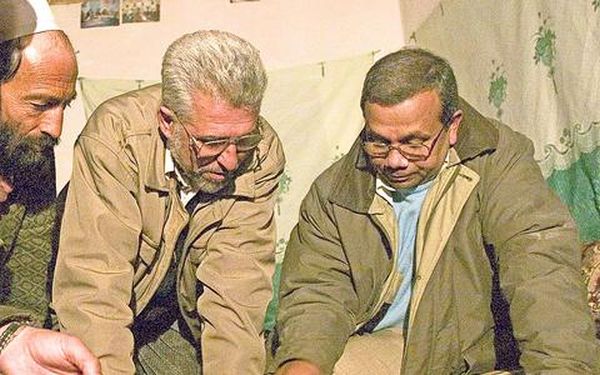Photo: tovima.gr
Ph.D. Osmund Bopearachchi, Professor at the Sorbonne and the University of Berkeley, and director of the archaeology department of "Hellenism and civilizations of the East" of the French Research Institute, believes he has found the only gold coin with the portrait of Alexander of Macedonia that was in circulation while the great military leader was alive, which has been preserved to date.
Moreover, it is not the only coin the researcher can show. His work in troubled areas of Afghanistan and Pakistan associates him with the discovery of coins that bear the names of previously unknown Greek Indian rulers and ancient Greek cities as well as with the discovery of a coin treasure with a total weight of 4 tons, one of the largest ever discovered.
Dr. Bopearachchi has recently visited Greece to open an exhibition called "Greek kingdoms in India and Bactria" in the Numismatic Museum, which will run until 16 June 2014.
A true modern Indiana Jones, he looks for his discoveries in the markets of Central and South Asia as well as in private collections while auction houses often call him to assess the authenticity of ancient coins. What he finds often goes beyond imagination, like in the case of the gold coin with the face of Alexander of Macedonia for example.
According to Dr. Bopearachchi, the coin belongs to a collector who is thinking of giving it to a museum some time.

Ph.D. Bopearachchi (to the right) Photo: exagorefsis.blogspot.com
After the Battle of the Hydaspes River
"I'm sure the case is about a coin (a commemorative medal), minted after the Battle of the Hydaspes River and the defeat of Indian king Por. There must have been other such coins with the same portrait, given to the generals of Alexander of Macedonia. This is the first portrait of Alexander the Great", Dr. Bopearachchi explains about the coin, which depicts the Macedonian king with an elephant-skin headdress (a symbol of India ) as well as the shield with the Gorgon and the curved horn of Zeus-Ammon.
Some researchers, namely four, dispute the authenticity of the coin, as stated by Dr. Bopearachchi, whereas scientists like Andrew Stewart and Frank Holt (who developed the hypothesis of the reason why this coin was minted) support him.
"During the Battle of the Hydaspes River in 326 BC, Alexander had to deal with an army of 250,000 elephants. He himself had only cavalry. Then he did something brilliant: part of the cavalry attacked frontally and two other parts made a flank attack. There was a commotion and the elephants, frightened, began to go around, treading upon Indian soldiers. You cannot beat elephants, if you're not a genius, but Alexander was one," says the scientist.
Among a pile of coins
However, where did Bopearachchi find the coin that, according to him, had been minted to commemorate the event that had changed the geopolitical map and history of the area?
He found it in a pile of coins with a total weight of 4 tons, consisting of 550,000 coins (from the 5th century BC to the 2nd century AD), as well as other gold, gold-plated and silver objects, a real treasure found in a large pit full of water near the village of Mir Zakah in eastern Afghanistan, where a treasure was found for the second time in a row.

Photo: exagorefsis.blogspot.com
The first time was in 1947 when they found about 30,000 coins. The coins were transferred to the National Museum in Kabul but were stolen during its destruction in 1993.
One can only guess why so many valuable items were found at the bottom of a pit, the size of a small lake. Perhaps the most convincing explanation is that robbers had hidden the loot stolen from palaces and castles in the lake, to which they had not returned for unknown reasons.
"I had the chance of being in the market in Peshawar (Pakistan) in 1994, when the first bags of coins and other valuables arrived. I found myself in front of a treasure of coins, perhaps the largest amount ever seen by a numismatist within such a short time. I was amazed. The first thing I could do was to find out the composition of the treasure," says the scientist, adding,
"Under enormous pressure I began to classify the coins into groups, according to their place of minting, into Indian, Greek, Greek-Indian , Indo-Scythian, of Kusan dynasty, etc. I have studied the coins from two treasures found in Mir Zakah in 1983. This fact has left its mark on me. I am delighted that I can publish new types of coins and discuss issues related to coinage in India and Central Asia."

Photo: exagorefsis.blogspot.com
"At the same time, however, it is a curse to know that the majority of these coins have been lost forever or ended up in private collections which we cannot access. It is however interesting that the gold coin was found in this treasure and I published it," adds the scientist.
Ancient Greek cities
Dr. Bopearachchi can relate things that are even more interesting. For example, about the discovery of ancient Greek cities in different regions of Pakistan, such as the one he accidentally discovered in the village of Sarai Saleh, Haripur.